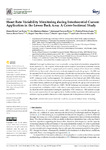Heart Rate Variability Monitoring during Interferential Current Application in the Lower Back Area: A Cross-Sectional Study

Use this link to cite
http://hdl.handle.net/2183/27667Collections
- Investigación (FEP) [507]
Metadata
Show full item recordTitle
Heart Rate Variability Monitoring during Interferential Current Application in the Lower Back Area: A Cross-Sectional StudyAuthor(s)
Date
2021-03Citation
De-la-Cruz-Torres, B.; Martínez-Jiménez, E.; Navarro-Flores, E.; Palomo-López, P.; Abuín-Porras, V.; Díaz-Meco-Conde, R.; López-López, D.; Romero-Morales, C. Heart Rate Variability Monitoring during Interferential Current Application in the Lower Back Area: A Cross-Sectional Study. Int. J. Environ. Res. Public Health 2021, 18, 3394. https://doi.org/10.3390/ijerph18073394
Abstract
[Abstract] Vasovagal reactions may occur occasionally during electrical stimulation using interferential current (IFC). The purpose of this study was to examine variations in autonomic activity during the application of IFC in asymptomatic participants by analysis of their heart rate variability (HRV). Seventy-three male volunteers were randomly assigned to a placebo group (n = 36; HRV was documented for 10 min, both at rest and during a placebo intervention) and an intervention group (n = 37; HRV was documented for 10 min in two conditions labelled as (1) rest and (2) application of IFC technique on the lumbar segment). The diameters of the Poincaré plot (SD1, SD2), stress score (SS), and the ratio between sympathetic and parasympathetic activity (S/PS) were measured. After interventions, differences amongst the placebo group and the IFC group were found in SD2 (p < 0.001), SS (p = 0.01) and S/PS ratio (p = 0.003). The IFC technique was associated with increased parasympathetic modulation, which could induce a vasovagal reaction. Monitorization of adverse reactions should be implemented during the application of IFC technique. HRV indicators might have a part in prevention of vasovagal reactions. Further studies in patients with lumbar pain are needed to explore possible differences in HRV responses due to the presence of chronic pain
Keywords
Interferential current
Heart-rate variability
Autonomic balance
Sensor technology
Heart-rate variability
Autonomic balance
Sensor technology
Editor version
Rights
Atribución 3.0 España
ISSN
1660-4601






